In spite of all the changes in the High Street, there are still all sorts of little clues in the buildings that somehow survive from the past. These are a few of them I have noticed when walking up and down the street – thanks also to Andrew Hawkes for pointing some of them out.
There aren’t many dates on the High Street buildings but one exception is the former Midland Bank on the corner of Chapel Street, now the Cashino. This has 1924 on the rain spouts, identifying when it was built. Scaplen’s Court also has a date on it but in this case the 1986 refers to the year in which the front range of the building was reconstructed, having been ruined and opened to the sky for 60 years. Another date I have read about but never seen is the year 1704 apparently somewhere on a rainwater head of the Barfoot mansion house, now Ginali’s restaurant at No. 87.
Beech Hurst also has a date on it, round the back in this case. On an oval stone plaque are the initials of the builder of the house, Samuel Rolles – S A R and the year 1798. The footbridge over the railway bears the date 1874 and there are three other dates in full sight on High Street – 1665, 1692 and 1878. Can anyone tell us where these are, or any more dates you can think of? In fact, now I come to think there are quite a few dates after all!
Some walls still carry old signs. One of these is the Beehive Stores sign on the side wall of the shop on the corner of New Orchard. So far, I haven’t tracked down the date of this. The shop was an outfitter’s from the end of the 19th century, run by Angel Hodges, then by William Travers and then Foster Brothers. Which of them called it ‘the Beehive Stores’ or does the name go further back still? On the wall of No. 77 is an advertisement for Lipton’s, the grocer’s and tea merchant’s. The shop was there in 1903 and had gone by 1923 – that’s the nearest I can get to the dates. Anyway, the sign has survived for around 100 years. Another very faded sign on the wall of Bowling Green Alley points the way to the police station which used to be behind the Guildhall where the widened New Orchard now cuts through.
Bennett’s the baker’s at No. 117 used to be Bright’s as the sign in the entrance way shows. Joseph Bright came from Wimborne and set up in High Street in the 1920s. He was several times Champion Baker and was Poole’s longest serving Mayor, remaining in office for 7 years throughout World War II. There also used to be a sign in the entrance of Hawkes’ shoe shop. I wonder if it is still there under the mat?
There are various architectural bits and pieces remaining after alterations to the buildings. One obvious example is in the coach entrance of the Antelope where it’s easy to see the original stone structure with the brick and plaster façade stuck on the front. This process was applied to lots of buildings in the 18th century when Tudor stone buildings were felt to need a face lift to bring them up to date. Another can be seen in Weston’s Lane by the side of No. 89, Yates’ Wine Lodge. Originally Butler and Sons draper’s, this three storey shop was built in the 1890s in front of half of what was once William Barfoot’s mansion house. Later it became Bon Marché, Poole’s first department store. The shop incorporated the premises behind, but the stone quoins of the original house can still be seen half way down the side wall.
Back in the 18th century there were many hazards to pedestrians walking along the then unlit street at night, dung heaps, piles of stones and timber that had been left lying around and the steps leading up to the doors of many of the buildings. The dung heaps etc. were eventually banished but the steps remained and the local newspaper had a campaign against them before the first World War. Today there are only very few remaining, for instance at No. 94 and in front of Cinnamon House.
If you are passing the Antelope coach entrance, have a look for the old hinge posts and hook for the big gates that used to close off the inn yard. Last but not least, check the side wall of the Spotted Cow (once the King’s Arms) for a curious metal ring. It looks like a hitching ring and judging by the height must be for horses rather than anything else.
I’m sure there must be lots of other clues to the past and would love to hear about any that people know of.
Jenny

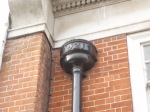
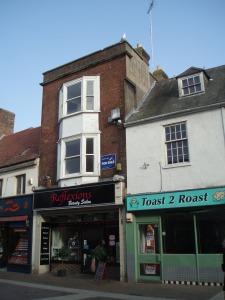
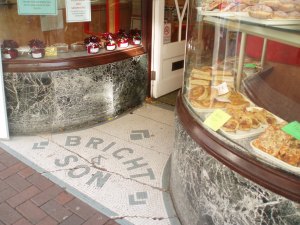
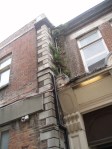
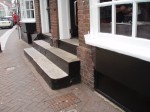
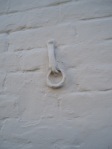
I find the history of Poole fascinating, some of the road names were named after sailers/merchants and families. Poole and Dorset Herald became The Advertiser. What is now The Job Centre on Dear Haye Lane and before that Market Stalls, my father owned the premises in the 1960’s called ‘Westons DIY’, the building before this time used to be an old brewery (probably why he brought it)!…
Thanks for your comment. There are a lot of interesting stories attached to various streets and buildings. Talking about breweries – have you come across the book ‘A Pint of Good Poole Ale’ by Andrew Hawkes? It’s very good on pubs and breweries.
Jenny
why called bowing green alley were they bowling
how many pubs really think lot more than2day so manybmissing
like christchuch old but think hangisbury head is far older